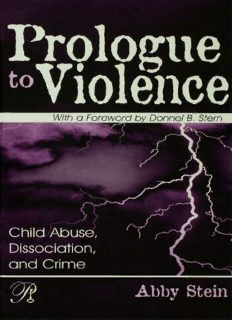
Prologue to Violence: Child Abuse, Dissociation, and Crime PDF
Preview Prologue to Violence: Child Abuse, Dissociation, and Crime
Prologue to Violence Child Abuse, Dissociation, and Crime Psychoanalysis in a New Key Book Series Volume 5 Copyrighted Material Psychoanalysis in a New Key Book Series DONNEL STERN, PHD., SERIES EDITOR Volume 1 Clinical Values: Emotions That Guide Psychoanalytic Treatment Sandra Buechler Volume 2 What Do Mothers Want? Contemporary Perspectives in Psychoanalysis and Related Disciplines Sheila Brown Volume 3 The Fallacy of Understanding / The Ambiguity of Change Edgar A. Levenson Volume 4 Prelogical Experience: An Inquiry into Dreams & Other Creative Processes Edward S. Tauber and Maurice R. Green Volume 5 Prologue to Violence: Child Abuse, Dissociation, and Crime Abby Stein Copyrighted Material Prologue to Violence Child Abuse, Dissociation, and Crime Abby Stein THE ANALYTIC PRESS 2007 MAHwAH, NEW JERSEY LONdoN Copyrighted Material Names, dates, locations, and other unique characteristics of crime scenes and criminals have been changed to shield the identity of subjects. Parts of this book previously appeared in Contemporary Psychoanalysis: Vol. 37, #3, July 2001, pp. 443-451; Vol. 39, #2, April 2003, pp. 179-197; and Vol. 40, #4, October 2004, pp. 495-517. Dedication quote on page v is from Gerrard, N. (2003). Holly and Jessica-We'll never know. Obseroer, Sunday, December 21. Parts of this research were funded by the Harry Frank Guggenheim Foundation. © 2007 by The Analytic Press, Inc., Publishers All rights reserved. No part of this book may be reproduced in any form-by photostat, microform, retrieval system, or any other means-without prior written permission of the pub lisher. Published by The Analytic Press 10 Industrial Avenue Mahwah, NJ 07430 www.analyticpress.com Cover design by Kathryn Houghtaling Lacey Library of Congress Cataloging-in-Publication Data Stein, Abby Prologue to violence: child abuse, dissociation, and crime! Abby Stein. p.cm. Includes bibliographical references and index. ISBN 978-0-88163-416-7 - 0-88163-416-6 (cloth) Printed in the United States of America 10 9 8 7 6 5 4 3 2 1 Copyrighted Material Pedophiles are other people; rapists are other people; murderers are other people. It's hard for the mind to know itself as wicked. It tells itself a different story, keeping the darkness at bay. -Nikki Gerrard v Copyrighted Material Copyrighted Material Contents Foreword by Donnel B. Stem ix Preface xv 1 Who Me? Locating Agency in Violent Narratives 1 2 Conversing with Mutes 19 3 Criminals' Bad Luck 39 4 Maximum Perversion 61 5 Dreaming While Awake 87 6 Conclusion: Consciousness, Culpability, and Control 113 References 131 Acknowledgments 143 Index 145 vii Copyrighted Material Copyrighted Material Foreword I edit the journal Contemporary Psychoanalysis, and that is how I learned about the work of Abby Stein. Perhaps you can imagine how unusual it is for remark ably insightful, creative, and beautifully written submissions from unknown writers to come in over the transom. Such events are among the best things that can happen to an editor. You begin to read, without any particular expectations, and suddenly, to your surprise, you find yourself in the firm and confident authorial grip of someone you have never heard of. Who is this person? On the very best of these already rare occasions, you are taken to a place you did not know existed. Abby Stein's writing came to me that way; and I was taken by it that way, too. After the second or third of these papers from Stein, I proposed to her that she write a book on the subject that she was digging into more and more deeply with every installment of her work. And what a subject it is! In the book that resulted, Prologue to Violence, which you hold in your hands, Stein addresses one of the most daunting problems of contemporary life: the role of childhood trauma (and she means serious trauma: violent, physical, sexual) in the creation of violent adolescents and adults (and, again, she means violence in the most serious way-beatings, rape, and mur der). The existence of this developmental picture is hardly news, of course. We all know that violence in one generation begets violence in the next. But Stein, having studied violent adults, both in person and in the files of law enforce ment agencies, draws a radically unfamiliar set of conclusions from this dis tressingly familiar developmental history. The key observation Stein makes, over and over again, is that violent crime is very often carried out in a state of dissociation. The offender either does not know he has done the crime or feels as if someone else inside him did it; or he presents in a kind of daze about the act. Stein quotes such a profusion of utterances of this kind from her subjects that the reader is left with no doubt at all about the dissociative processes involved. All by itself (that is, even without the heart of Stein's argument, which I will get to), this observation amounts to a challenge to the most common interpre tations of criminal violence. Most often, Stein tells us, violent criminals are not conscienceless; they are not, in other words, what we are used to thinking of as psychopaths or sociopaths. They are not simply evil; or rather, if they are evil, ix Copyrighted Material
Description: